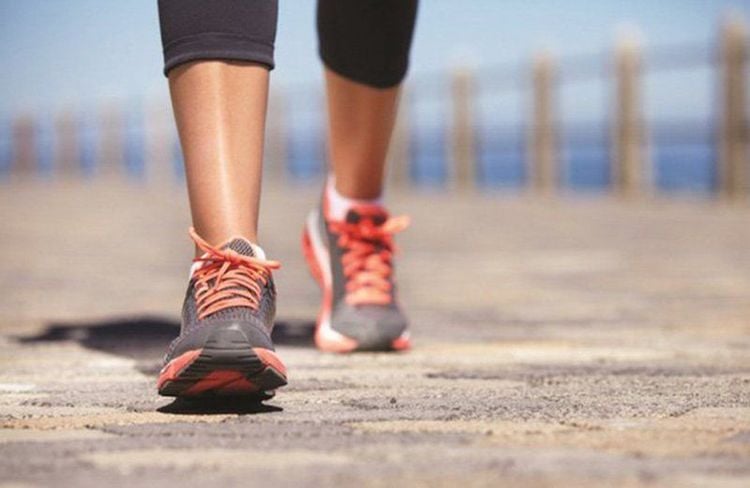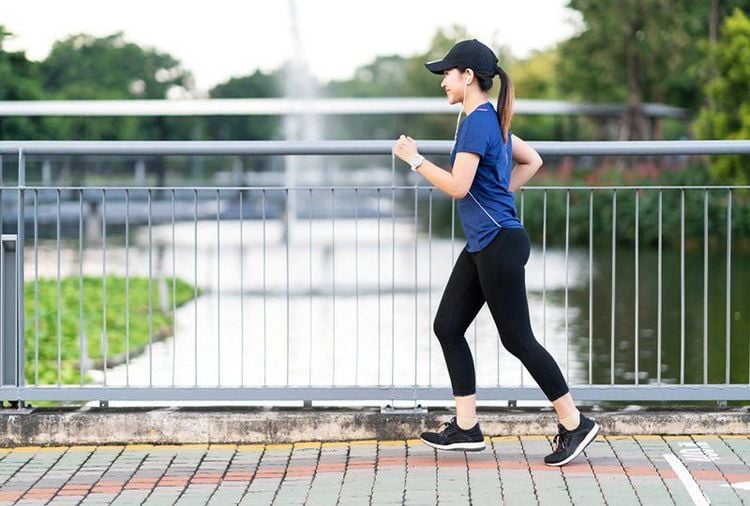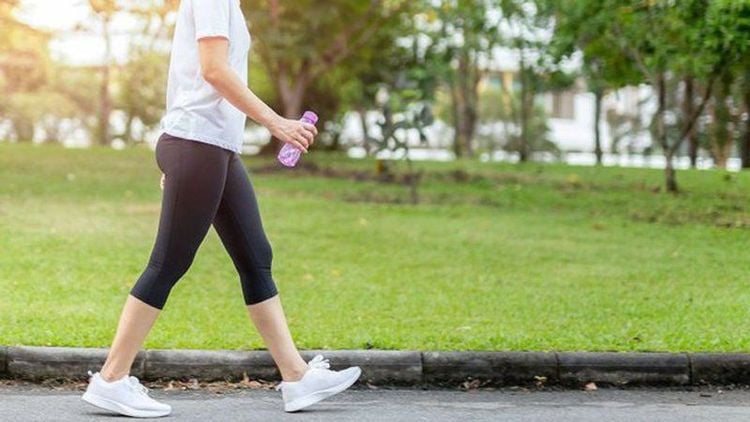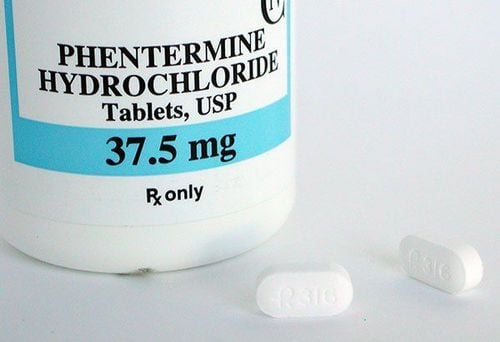This is an automatically translated article.
Unlike other forms of exercise, brisk walking has a lower risk of injury and is a low-cost activity. When people walk briskly a few times per week, they can get health benefits, such as lowering high blood pressure and reducing their risk of developing type 2 diabetes. In this article, we describe in more detail what brisk walking is and the techniques of brisk walking.
1. What are the effects of brisk walking?
Brisk walking is a moderate-intensity aerobic activity and a good way for people to increase their activity levels or ease into a more active lifestyle. The Centers for Disease Control and Prevention (CDC) determines that moderate-intensity aerobic activity causes exercisers to sweat and raise their heart rate. As a general rule, for a person to be able to walk briskly, they need to be traveling at a maximum speed of 6.75km/h. A person should aim to walk briskly every day for at least 30 minutes.
Here are the benefits that brisk walking gives you:
1.1. Brisk walking helps you lose weight faster Every day you walk briskly for about 30 minutes can reduce 200 calories. Actual calories burned depends on several factors such as:
Walking speed Distance you travel Terrain (you will burn more calories walking uphill instead of walking on level ground) Your weight You do not have to exercise, but you can form a habit of walking briskly several times a day to keep fit. This method is extremely effective when combined with a healthy diet and is the perfect way to stay fit all year round.
1.2. Get a Stronger Immune System Your body has amazing functions and it can do many things like disease prevention and control as long as it is well taken care of. In addition to replenishing vitamins, minerals and other necessary resources for the body, a brisk walk can be another way to boost your immune system and ensure that your body is working at top speed.
Regular walking helps the body create T cells, which are cells that fight against infected cells in the body. Infected cells are harmful to the immune system because they damage and limit regular functions necessary for healthy living. By generating more T cells, brisk walking aids the body in its fight with harmful cells.
One study followed 1,000 adults during flu season. People who walked at a moderate pace for 30 to 45 minutes a day had 43% fewer sick days and fewer upper respiratory infections overall.
Their symptoms also ease if they get sick. This number was compared with the adults in the study who were sedentary.

Đi bộ nhanh giúp tăng cường hệ miễn dịch của cơ thể
1.3. You can relieve back pain with a brisk walk Back pain is one of the most common discomforts and can actually turn into a pretty serious condition if left untreated or cared for. It can be due to irregular exercise, wrong sitting posture or even choosing a bad mattress. Brisk walking is one of the top suggestions for back pain relief given by musculoskeletal doctors. It can help the body release serotonin and endorphins and thus eliminate pain without medication (depending on the specific condition).
Walking briskly for low back pain can be extremely difficult at first but the advice is to start slowly and gradually increase the pace as your back adapts to the movement.
1.4. Solve circulation problems Walking at a faster pace can help keep your heart healthy and your circulatory system stronger. In fact, walking briskly for a few miles each day lowered blood pressure by more than 11 points over a 6-month period.
If you have serious circulatory problems it is best to consult your doctor about how brisk walking will help eliminate your problem
1.5. Strengthens bones For patients with osteoporosis, brisk walking is a great way to eliminate the risk of losing bone mass. This activity can even help provide bone strength and even increase bone density. This is also a great way to work out your leg and abdominal muscles. If done correctly and with correct posture, abs and waistline can also be toned.
1.6. Relieve Stress and Anxiety A brisk walk is an ideal choice for those who want to blow off steam while exercising. If you are already too stressed with work or negative with a situation or a person, then a brisk walk is a wise choice to clear your mind.
The science behind brisk walking explains this through the release of endorphins and other chemicals that boost emotions.
1.7. Your body is less susceptible to chronic diseases In general, forming a habit of regular brisk walking can help you prevent a chronic disease from becoming a problem for your body. It can actually be a preventive measure for a number of diseases, including heart stroke or heart disease. Brisk walking leads to lower LDL cholesterol (the bad cholesterol in the body) and higher HDL cholesterol (the good cholesterol in the body).
If your readings have crossed the safe threshold, then try a brisk walk for 15 minutes after a meal, you can lower your blood sugar in more than 24 hours.
1.8. Brisk walking is good for your joints Another benefit of brisk walking is the effect it has on joints. Articular cartilage lacks a direct blood supply, and its only source of nutrition is synovial fluid that circulates through your body when you move. When you walk, the cartilage is squeezed and delivers oxygen and nutrients to the area. In other words, infrequent walking leads to joints not receiving enough life-giving fluids and they can become damaged and injured easily.

Đi bộ nhanh giúp khớp xương linh hoạt và dẻo dai
1.9. It's a great way to boost your energy. All of the benefits listed above show that brisk walking can overall provide the energy boost you're looking for. Walking increases the flow of oxygen in the body. Brisk walking can also increase cortisol, epinephrine, and norepinephrine levels. These are hormones that help raise energy levels.
Especially if you try it with your favorite music, the results will be amazing.
1.10. Extends your life Researchers have found that walking at a moderate versus slow pace reduces the risk of death by 20%.
But walking at a brisk or brisk pace (at least 4 miles per hour) reduces risk by 24 percent. The study looked at the association of walking at a faster pace with factors such as overall cause of death, cardiovascular disease, and cancer mortality.
1.11. A social activity that can be shared with everyone. A brisk walk is an extremely useful social activity that can be done with friends or loved ones. This is also a great way to meet new people and make new social connections. A brisk walk can be the perfect little respite from the daily routine and open up a whole new world of relaxation and most importantly, it has health benefits.
2. Brisk walking technique
2.1. Technique Turning your ordinary walk into a stride requires purposeful posture and movements. You should adjust to the following posture:
Start slowly to warm up and warm up your body: Walk slowly for 5 to 10 minutes to warm up your muscles and prepare your body for exercise. Your neck, shoulders, and back are relaxed, not stiff upright. You are swinging your arms freely with your elbows slightly bent. Inflating with your arm is fine. Your abs are slightly tight and your back is straight, not arching forward or backward. You are walking gently, rolling your feet from heel to toe. At the end of your walk, take a slow 5-10 minute walk to help your body cool down. After cooling down, gently stretch the muscle. If you want to stretch before walking, remember to warm up first.

Nên khởi động cơ thể trước và sau buổi đi bộ để nâng cao hiệu quả tập luyện
1.2. Establish a performance goal and try to keep it up For most healthy adults, the U.S. Department of Health and Human Services recommends at least 150 minutes of moderate aerobic activity or 75 minutes of vigorous aerobic activity , or an equivalent combination of moderate and vigorous aerobic activity. The guidelines recommend spreading this exercise over the course of a week. It's also a good idea to do strength-training exercises for all major muscle groups at least twice a week.
The general goal is to get at least 30 minutes of physical activity each day. If you can't spend that much time, try a few short activities during the day. Any amount of activity is better than no activity at all. Even a small amount of physical activity is helpful, and activity accumulated throughout the day provides health benefits.
Remember that you can start slowly - especially if you don't exercise regularly. You can start with five minutes a day for the first week, then increase your time by five minutes a week until you reach at least 30 minutes.
For more health benefits, try to get at least 60 minutes of physical activity most days of the week
If you have little or no experience with brisk walking, don't let this you scare or discourage you. This activity may not be easy for beginners but once you get into the habit of gradually increasing your walking speed, you will find that it won't be long before you become a brisk walker. Track your growth and, if necessary, track how fast you are moving to ensure that you are making progress over time
Hope the information above has provided you with more helpful brisk walking answers What use? Wish you always have a scientific diet and improve your work productivity and improve your life.
Please dial HOTLINE for more information or register for an appointment HERE. Download MyVinmec app to make appointments faster and to manage your bookings easily.
References: mayoclinic.org, medicalnewstoday.com, healthline.com












